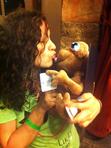Red Harvey's Blog, page 5
October 10, 2012
"Fundamentals of Character Theory"
 "The Vampire"
"The Vampire"By Phillip Burne-Jones (1897)
Source: Wikimedia CommonsEvery novel is a chance to explore a new world. Anne Rice brought us to the “realistic” life of the vampire with her novel Interview with the Vampire. Dan Brown made history cool again with The DaVinci Code. Part of what makes those books so memorable are the characters. An entire book told from an interview perspective would have gotten old quickly had Louis not been so sensitive and articulate, had Lestat not been so diabolically charming. And only Robert Langdon could solve academic mysteries a la Indiana Jones style while keeping the reader interested. Plot, setting, and pacing are certainly important assets for any good novel. However, a remarkable character can be the difference between a memorable novel and a book that is easy to put down.In the literary world, character theory is always mentioned in passing. Character theory has been left largely unexplored. There are many reasons as to why, starting with how characters resemble human beings, and it is hard to condense a human being into word form. Closely examining a character can be just as difficult; difficult but not impossible. Throughout this paper, two questions will be explored: what are the prevalent aspects concerning character theory, and what makes characterization important in a novel? Stephen King novels and his methodology concerning characterization will be used as a basis of comparison.Character theory involves a myriad of factors, beginning with the different types of characters.Types of CharactersAt its base definition, a character is the portrayal of a human in a fictitious work of art. The role played by the character indicates who they are to the reader, and the characters is further defined by their role.According to author Christina Myers-Shaffer, there are seven common roles found in literature: hero, superhero,anti-hero, villain, protagonist, and antagonist. Sometimes a character can encompass more than one role, and Bill Denborough from King's IT is one such character. Bill is the main hero in IT, but in combination with his psychic abilities and childhood stutter, he is also a superhero and an anti-hero. It is this very complexity that leads to the categorization of character roles. For example, Bill is not just a hero, he is a round character as well. A round character cannot be easily defined and cannot be contained by one role, whereas a flat character can be "summed up in one sentence," (Forster 224). Stock characters are expected to be found in a particular story, such as fairy tales featuring swooning princesses and evil witches. Type characters represent an entire class or group of people. Stereo types are the last subset of characters and they are predictable in their actions that are usually derived from cultural assumptions. Of all the characters sub-sets, flat and round are the most fascinating, thanks to E.M Forster's critique.
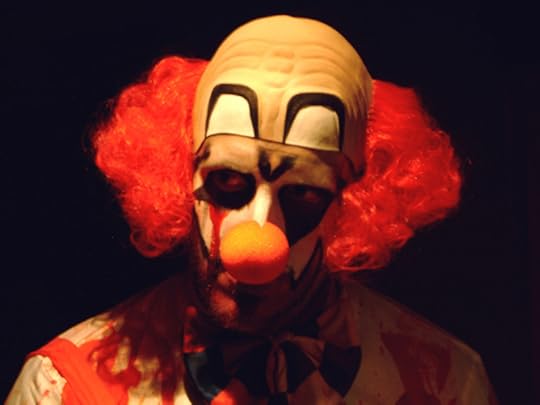 "Clown"
"Clown"By Graeme Maclean (2005)
Source: Originally uploaded from
Flickr to Wikimedia CommonsE.M. Forster was an author and literary critic. In his book Aspects of the Novel, he actually coins the literary terms 'flat' and 'round' characters. While many writers hope to evade flat characters, Forster makes the case that flat characters can lend an advantage to storytelling in two ways: they are easily recognized and easily remembered, (227). Forster is aware that in life human beings can rarely be summarized in one sentence, but he contends that in novels, they can and should be. Books can be overcome by a cast of strictly round characters because then there would be no room for anything else. Flat characters help to move the story along, like Mr. Nell in IT. He is an Irish policeman concerned with the dam built by the children that is flooding the town, and that is all he is. Even so, he is the necessary catalyst that shifts the children's focus from dam-buidling to taking down the monster, Pennywise. Everyday, there are people like Mr. Nell who come in and out of the picture suddenly, but their impact on a life can be profound. Forster says something similar of literature, "A novel that is at all complex often requires flat people as well as round, and the outcome of their collisions parallel life [...] accurately," (227).Classifying a character type can become formulated, but the art of character creation is a bit more subtle.How to Create a CharacterDeciding factors in a character's development can stem from environmental or cultural influences. Myers-Shaffer reports that there are four elements used to shape a character: attitude, emotional state, response mechanisms, and intrinsic values, (175). By attitude, Myers-Shaffer means the way a character carries themselves. Emotional state is the intense responses felt by a character. A response mechanism is the way in which a character deals with situations. And finally, intrinsic values are the layers (or lack of) morals inherent to the character's personality. Cohesively, those four elements can be used to create a character, but there are other unconventional methods to characterization.
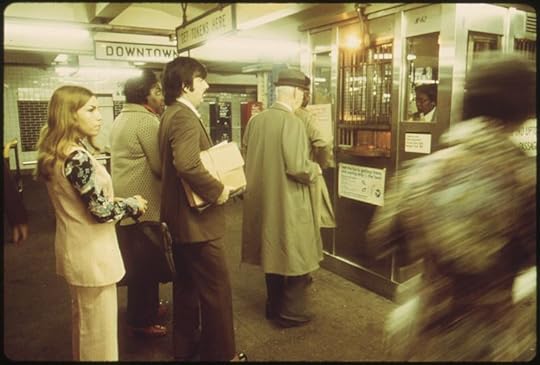 "Passengers Waiting in Line..."
"Passengers Waiting in Line..."By Jim Pickerell (1936)
Source: Wikimedia CommonsTo make a new character, it isn't necessary to adhere to a list of literary elements. Character creation can be as easy as considering the klutz of the office, or a friend's over-the-top mother. Either one of those people can form the base of a realistic character. A conversation overheard at the store or waiting in line at the bank could prove useful in character development as well. If a book can mimic real life, why not use everyday people and conversations to make new characters? Ideas like these are taken from Orson Scott-Card's book Characters and Viewpoint. Scott-Card notes that "what seems ordinary to you will seem strange to someone else" (162). Perspective is the key; Scott-Card is saying that no one leads an ordinary life, therefore a writer needs only to look around for potential characterization material. Of course, the method in which a character's details are presented is essential to preserving their validity to the reader. Character details can overlap with motivation, another character creation tool.Motivation is an underrated part of character theory. Authors worry about the character's appearance, dialogue, actions, and that is when motivation can get lost, (Janeczko 9). Yet, motivation is useful in explaining character actions, background, and foreshadowing their possible future.Why is a character mean/nice, smart/stupid, or a hero/villain? What drives them to the point that they are at now in the story? Past human interactions and situations can be used later in character development. For example, in King's fantasy novel The Gunslinger, anti-hero Roland Deschain's short-term goal is to pursue the man in black, and there are reasons why he wants to catch the man in black: Roland believes that the man in black holds the answers to finding the Dark Tower, which is Roland’s main goal in The Dark Tower series. Roland later believes the man in black may have been the person responsible for bringing about the end of his kingdom. These reasons help to shape Roland's personality, and they give insight to the reader on what actions he might next decide upon. Scott-Card warns that character motivation should not be overlooked because then the reader settles on their own idea of motive, usually an archetype or cliche, (106).An additional character creation method is to dissect characters from other novels. If a character like Roland can be taken apart for examination, his traits could help clarify for the reader what type of protagonist he resembles and why.
 "Childe Rowland to the Dark Tower Came"
"Childe Rowland to the Dark Tower Came"By Thomas Moran (1859)
Source: Wikimedia CommonsIt helps to begin by listing the characters distinguishing traits. A few words that could be used to describe Roland would be: powerful, relentless, cold, kind, focused. By Myers-Shaffer's standards, Roland possesses a mixture of positive and negative traits, thus he can be defined as an anti-hero. Like Bill Denborough, Roland fits the category of superhero, because he is trained in the sacred art of the Gunslinger, a talent that imbues the person with unnatural dexterity, speed, and precision while shooting a firearm. Character dissection can serve as concrete evidence of a character's persona.Apart from types of characters and character creation, there is another vital feature to character theory, and that is the function of major and minor characters.Major and Minor Characters“Not all characters are created equal,” (Scott-Card 59).A novel is a narrative that can feature one central character, or a cast of several central and surrounding characters. Central characters are also known as major characters, with the less marginal characters being dubbed minor characters. Despite the connotations of the names major and minor, the labels themselves do not dictate a character’s importance to the story, or their place in it.In his book, The One Vs. the Many: Minor Character's and the Space of the Protagonist in a Novel, author Alex Woloch describes the relationship between major and minor characters through comparison from Homer’s the Iliad: “The Iliad is about one life and many […] this arrangement of characters is structured around the relationship between one central individual who dominates the story and a host of subordinate figures who jostle for, and within, the limited space that remains,” (2).Woloch also speaks about the dilemma an author comes across when a major character must withdraw from the story for a period of time. How can a story progress? Woloch’s answer is that secondary characters then become essential in reflecting the conflict of the story from their point of view, (3).Minor characters differ in degrees of importance, from secondary to background. Secondary characters complement the major characters and are distinct because they can speak, emotes, and act out in ways that make the reader care for them. A background character is just the opposite, with his development being stunted. Background characters merit a quick mention, such as “The men arrived”, “My sisters laughed”, or “The people watched”. Background characters are a necessary element to a story because they instill a sense of reality; their presence shapes not just a story, but an entire world. Scott-Card advises that when creating background characters, a writer should remember that there are people in the story who must be there, who might be there, and who have been there, (34-35).The idea of the major and minor character can seem redundant after discussing round and flat characters. It is an assumption that they are one and the same. However, that is not true, since a major character is capable of being flat, and a minor character is capable of being round.
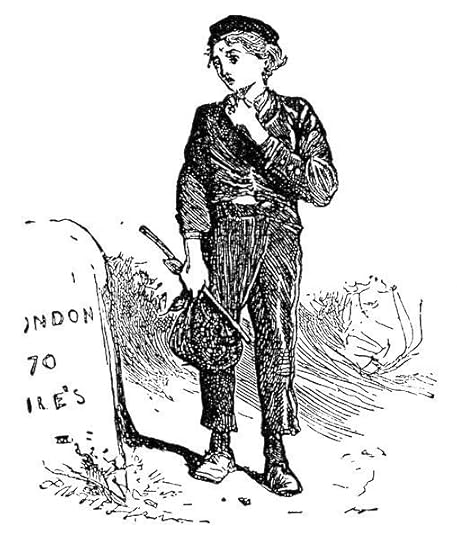 "Oliver Twist"
"Oliver Twist"By James Mahoney (1898)
Source: Wikimedia CommonsDickens is an author who is accused of using flat characters as his constant in every book. Major characters from any Dickens novel manage to capture a reader’s interest and hold it. Yet, that is not due to the character’s depth; “Probably the immense vitality of Dickens causes his characters to vibrate a little, so that they borrow his life and appear to lead one of their own,” (Forster 227). Consider Oliver Twist’s character: his is innocent, naive, and trusting. Twist shares the traits of many fairy tale protagonist, and like a fairy tale, Oliver Twist gets his happily ever after. There is little to learn from Twist as a character that they reader has not already seen in other hero-types. Nevertheless, Twist is the major character in Oliver Twist.An exemplary minor character that exhibits round attributes would be Allie from The Gunslinger. At first, she is merely a bartender, made noticeable by the scars on her face. Roland Deschain notes that, “if she had been pretty once, it had moved on long ago” (King 34). Allie starts to emerge as a minor character of greater significance after she tells Roland that she cannot rid her mind of the thought of asking a dead bar patron (brought back to life by the man in black’s magic) about the afterlife. She knows the answers wrought from the dead man would drive her insane, but she wants to know them anyway. She exercises restraint, until she gives in to the madness, at which point she begs Roland to kill her. From King’s initial description of Allie, the reader assumes she is a mean, ugly woman only meant to serve Roland a beer and then move on. Allie becomes more than the reader could have presumed upon, and through her interactions with the major character, Roland, the reader sees that Roland is not made of stone. Allie humanizes Roland, and she lends her own depth to glorify his at the moment of her death by his hand.Stephen King is known for creating memorable characters, whether they be major or minor in magnitude. He has created an intricate network of literary characters that can interact with one another through different novels. By doing this, King has made what some of his fans refer to as “The King Universe”.The King Universe
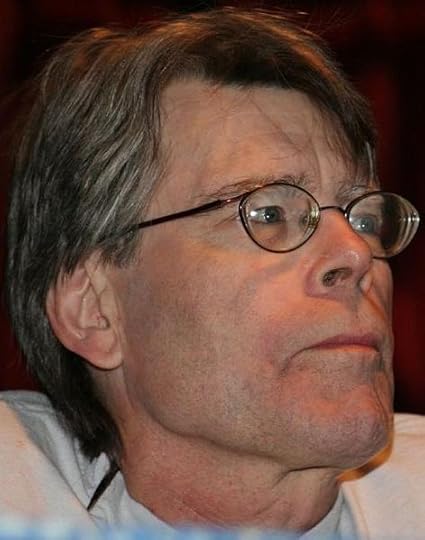 "Stephen King at 2007's Comicon"
"Stephen King at 2007's Comicon"By Pinguino
Source: Originally from Flickr,
uploaded to Wikimedia CommonsOn Writing is King's semi-autobiographical account of his life as a writer and his tips on how to become a good writer. Briefly, King outlines his approach to characterization: "The situation comes first. The characters- always flat and unfeatured to begin with- come next. [While narrating] I have an idea of what the outcome may be, but I have never demanded of a set of characters that they do things my way. On the contrary, I want them to do things their way," (165). King gives his characters free reign in a story, allowing them to make the story their own through their actions and words. Characters even break free from one book to show up in another.In most every novel written by King, there is a mention or interaction with characters from previous novels. There could be a reason as to why King does this: it is fun for him and/or he wants to solidify the world his characters reside in to his audience. Scott-Card is a like-minded author that feels “the characters in your fiction are people. Human beings,” (6). It would then make sense to a reader why characters form different novels could be aware of one another, since human beings are also aware of one another, regardless of a separation of distance or words. King runs with this idea, and here are some examples of character links:
Salem's Lot-The Dark Tower: The Wolves of CallaFather Donald Callahan disappears in Salem's Lot (and presumed dead), only to appear in Wolves of Calla.
Eyes of the Dragon-The StandRandall Flagg appears in both books in some form as an antagonist.
The Regulators-Desperation-The Dark Tower SeriesTak is the main antagonist in both Desperation and The Regulators, and he is also mentioned in The Dark Tower series as a mischievous spirit.
The Regulators-DesperationBoth books feature the exact same array of characters, juxtaposed in an alternate dimension.
The Dark Tower series has numerous character links to other books, as characters are 'pulled' out from books (like Father from Salem's Lot) and put into the story of The Dark Tower. Another prominent character connection is the one between Dolores of Dolores Claiborne, and Jessie Burlingame of Gerald's Game. At the same moment in time, though they are separated by miles, both women experience a psychic connection with each other that occurs during the solar eclipse that is paramount to each novel. It is implied that either the power of their mutual suffering or the power of the solar eclipse enabled them to share minds for a fleeting moment.King doesn't only connect characters to emphasize the size of his universe. He also sets stories in the same towns, making sure to include landmarks, places, and other things. Derry and Castle Rock are two cities in Maine that receive plenty of attention in King's World. There are websites dedicated to the Derry Connection. Castle Rock is the setting or somehow mentioned in these novels: The Dead Zone, Cujo, The Body, Needful Things, Under the Dome, and Lisey's Story.Small details perpetuate the realism of the King Universe, such as Desperation's Ellie Carver reading the Misery Chastain novels, the various mentions of Shawshank Prison, The Inside View (a tabloid referenced in Desperation and The Dead Zone). The list of King connections could fill an entire book, and in fact, they do. Stephen Spegnasi crafted The Complete Stephen King Encyclopedia, a book that can be described as thicker than a telephone book in length. Spegnasi realized the potentially long list of links that complete the King Universe. There are plenty of other undocumented links to be found and taken note of, tenuous as they may be.King's Universe of novels is alluring both for the story and the world they immerse the reader in. From book to book, King's world is a palpable, breathing entity, made even more real by the characters he chooses to create that drive his stories.ConclusionCharacter theory is a vast territory to explore. The fundamentals underlining character theory are types of characters, character creation tools, and minor and major character analysis. Real people and motivation can develop characters in new ways, and help a story reach its potential. Characters are the bread and butter of any novel. It is a character's humanity that keeps the reader coming back. Unfortunately, a full understanding of character theory is difficult to grasp because of a character's realism. As Scott-Card said, a character is a human being.Works CitedCard, Orson. Elements of Fiction Writing: Characters & Viewpoint. New York: Writers DigestBooks. 1999. Print.Janeczko, Paul. “In Their Own Words: An Interview with Stephen King”. The English Journal69.2 (1980): 9-10. JSTOR. 6 October 2011.King, Stephen. Dolores Claiborne. . New York. Signet Publishing. 1993. Print.---. Gerald’s Game. New York. Signet Publishing. 1993. Print.---. The Gunslinger: The Dark Tower 1. New York: Viking Press. 2003. Print.---. IT. New York: Signet Publishing. 1980. Print.---. On Writing. New York: Signet Publishing, 2000. Print.Meyer-Schaffer, Christina. Principles of Literature, The: A Guide for Readers and Writers.Barron’s Educational Series. 2000. Print.Stevick, Phillip. The Theory of the Novel. New York: The Free Press, 1967. Print.Woloch, Alex. The One vs. the Many: Minor Characters and the Space of the Protagonist inthe Novel. Princeton University Press. 2003. Print.
Published on October 10, 2012 21:02
"Nightfall"- An Illuminating Short Story by Issac Asimov
 Source: CosmoGraphica.com
Source: CosmoGraphica.comCover for Asimov's "Nightfall"
Copyright 2010, Don Dixon Space Art
Writing legend Issac Asimov added to the genre of science fiction in a big way, most notably with his short story collection on robotic intelligence in I, Robot. One of his lesser known stories, "Nightfall" explores something entirely different: the limits of human knowledge.On the distant planet, Lagash, an eclipse is about to take place. The thought of an eclipse has the people of Lagash in a panic. Lagash is a special planet, home to four suns. Four suns means that Lagash is in a constant state of light. Darkness is a foreign concept to Lagash citizens. They do not even fully realize what stars are, or that an eclipse is a natural occurrence, not a supernatural event to fear. Every 2,500 years, Lagash has an eclipse. With each eclipse, civilization collapses due to insanity born of the fear of darkness. The only people that survive the eclipses without going insane are children, the elderly, and drunkards. The premise of the story seems ridiculous: one night of darkness is capable of collapsing 2,500 years of civilization? Yet, humans always fear what they cannot understand. Author Isaac Asimov takes note of this, and one of the characters in “Nightfall” says “[of the stars and darkness] You can’t conceive that! Your brain wasn’t built for the conception of infinity or of eternity. You can only talk about it. A fraction of the reality upsets you, and when the real thing comes, your brain is going to be presented with the phenomenon outside its limits of comprehension. You will go mad” (Asimov p. 8).
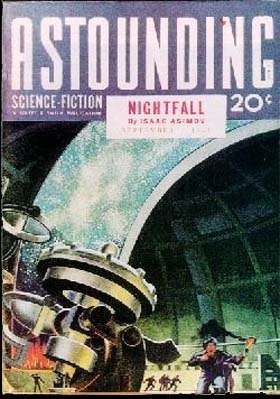 Source: UmMuseum.comStars, like infinity, are beyond the characters comprehension. One character has a ‘cute notion’ of the possible number of stars in the sky, stating there could only be a dozen or so, and no more. Another misconception shared by Lagash citizens is the idea that a planet with only one sun would be uninhabitable because “Life--which is fundamentally dependent upon light---[cannot] develop under those conditions [of partial darkness]” (Asimov p. 17). Religion is another part of the story that Asimov ridicules. The Cultists are a religious group founded around the worship of darkness and stars. They are the only people of Lagash that long for the eclipse, as they believe that starlight will cleanse their immortal souls. There are Earthbound religions that share similar sentiments of a promised salvation that must always come hand-in-hand with apocalyptic prophesies. Asimov’s story takes perceptions of what is possible and turns it on its head. From the perspective of an Earthling, Lagash citizens are laughable in their ignorance. The scary thing is that we Earthlings have our own dangerous misconceptions.
Source: UmMuseum.comStars, like infinity, are beyond the characters comprehension. One character has a ‘cute notion’ of the possible number of stars in the sky, stating there could only be a dozen or so, and no more. Another misconception shared by Lagash citizens is the idea that a planet with only one sun would be uninhabitable because “Life--which is fundamentally dependent upon light---[cannot] develop under those conditions [of partial darkness]” (Asimov p. 17). Religion is another part of the story that Asimov ridicules. The Cultists are a religious group founded around the worship of darkness and stars. They are the only people of Lagash that long for the eclipse, as they believe that starlight will cleanse their immortal souls. There are Earthbound religions that share similar sentiments of a promised salvation that must always come hand-in-hand with apocalyptic prophesies. Asimov’s story takes perceptions of what is possible and turns it on its head. From the perspective of an Earthling, Lagash citizens are laughable in their ignorance. The scary thing is that we Earthlings have our own dangerous misconceptions. “Nightfall” is a short story full of commentary on the true limits of human knowledge. In thinking that we know everything (Asimov is telling the reader), we know nothing. All of our petty reasonings designed to understand the scope of the universe and its inner workings are inadequate, especially when they’re founded on fear and superstition instead of fact.
Asimov, Isaac. “Nightfall”. Astounding Science Fiction (1941). Print .
Published on October 10, 2012 15:17
September 29, 2012
Orlando: The Man, The Woman
 Original cover
Original coverUser: El-luismi
Source: Wikimedia Commons
Orlando is a novel by Virginia Woolf that takes the idea of being a man and woman in one lifetime (or several lifetimes) and puts it to good use. The title character, Orlando, is a nobleman living in England during the Elizabethan period. He is content with his life except for the loneliness, having been engaged, married, or assumed to be engaged to four women in his lifetime. When he meets a Russian princess, he thinks that life has finally rewarded him with his one true love. Unfortunately, the princess does not reciprocate and leaves Orlando. Distraught, Orlando turns to his other passion: writing. He takes writing seriously, writing plays, poems, and stories, all odiously long. Away in his country manor he writes and writes, until he is visited by a famous writer Nicolas Green. Green reads Orlando's work and writes up a poem to satire it, thus making Orlando hate humans and turn even more inward while at his country estate.Later on, Orlando visits other European countries, encountering gypsies as he does so. One night, he has a strange dream, and as a by-product, becomes a woman. There is no shocking reveal or loathing from Orlando at having turned into a woman, only acceptance. With his/her new worldview, Orlando comes to see how different her life will be as a woman. Her return to London is a lesson in women's rights, because she realizes that she can no longer own her land, manage her finances, or vote. Small things come to Orlando's attention now that she is a woman, like the fact that men cannot cry in front of an audience. A man falls in love with her, and when she refuses him, the man begins to cry, and though Orlando knows from experience that men cry just as women do, that they are not supposed to openly weep, and so she is shocked at the emotion display of her thwarted lover.
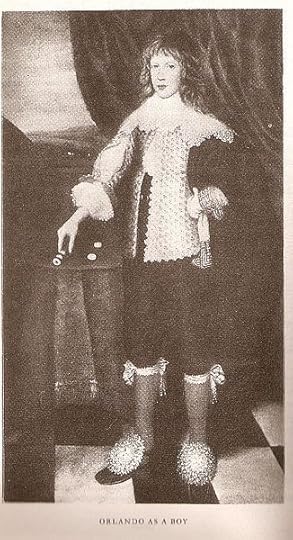 "Orlando as a boy"
"Orlando as a boy"paiting by Cornelious Nuie
(1650)User: El-luismi
Source: Wikimedia CommonsOrlando life spans many generations. He/she goes into deeps slumbers every few years, almost like a bear hibernating, and this (or some other type of magic) prolongs Orlando's life from the 1500's, taking the story all the way to the 1920's.As a man, Orlando never questioned his privilege or sexuality (believing himself to be inherently heterosexual and powerful). Yet, as a woman, Orlando's eyes open up to see that the world is often one-sided in its treatment of women. Orlando the man fought in wars and dueled men to the death, but he/she is aghast when a gentleman treats her like a dainty flower, as she feels much more capable than she is given credit for, not just as a woman, but as an equal division of humanity.
Woolf, Virginia. Orlando: A Biography. New York: Harcourt Brace & Company, 1956. Print.
Published on September 29, 2012 21:15
September 12, 2012
"The end of masculinity would also mean the end of femininity", and other thoughts from Marlene Barr
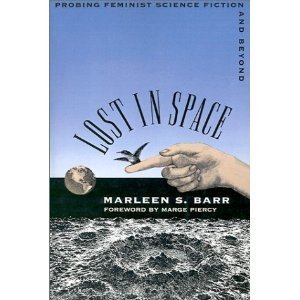 Source: Google Images
Source: Google ImagesAll female societies, pregnant nursing males, and the end of masculinity are only a few of the topics discussed by Marlene Barr in her book Lost in Space: Probing Feminist Science Fiction and Beyond. Through a series of essays, Barr comments on the equality (or disproportions) between men and women, using feminine sf stories as a basis of comparison. Authors like LeGuin, Russ, and Gilman are quoted by Barr, though she is fair in her feminist sf study by including male authors (an unwanted but undeniable presence in feminist sf).
In the introduction to her SF analysis, Barr shares the story of her academic rise. By choosing to study sf through a feminist lens, Barr says that many of her male colleagues were threatened and tried to negate the academic quality of sf for study. Sf writer Gary Westfahl is quoted by Barr, warning sf writers to “never conceal, compromise, or apologize for [your] interest in this field” (p. 2). If sf was a laughable avenue of study to her colleagues, Barr realizes that a feminist-led criticism sf might be met with greater laughter. Still, she forges ahead with the dismantling of patriarchal sf by comparing them to feminist sf stories of the same caliber.
Chapter 6 talks about the end of masculinity. At face value, the term ‘end of masculinity’ could be interpreted as a threat to men everywhere. What Barr means by the end of masculinity is to also end the other side of that particular coin, femininity. Like ying and yang, one cannot exist without the other. Without masculinity or femininity, men and women would unite under a singular definition of gender, one in which both men and women would be caregivers, providers, and valuable members of society. Barr's text is a valuable tool in the study of sf, especially given her gender critiques.
Barr, S., Marlene. Lost in Space: Probing Feminist Science Fiction and Beyond. North Carolina: The University of North Carolina Press, 1993. Print.
Published on September 12, 2012 21:17
August 15, 2012
The Themes Found in "A Handmaid's Tale"
 "Handmaid Under the Eye"
"Handmaid Under the Eye"Created March 11, 2008
by Segeton
Source: Wikimedia Commons
In the early 1970’s, radicals took over the United States, killing the President and all of Congress simultaneously. To erect their totalitarian regime, the country’s new founders suspended the Constitution to create their own laws. These laws include are mostly anti-laws steeped in Christian sentiments, like anti-abortions, anti-sex (citizens are denied sex unless they are married, and even masturbating is a punishable offense), anti-free speech, and even anti-literacy (for women). Offred is a Handmaid of the Republic of Gilead. The remnants of the United States is now Gilead, and woman are no longer allowed to have a job or own property in Gilead. A rise in sterile men and women has prompted the leaders of Gilead to promote the use of Handmaids. Handmaids like Offred are put into households of commanding army officers to do what their sterile wives cannot: produce a child. Often, a Commander is sterile (though it is treasonous to blame men for anything in Gilead), and a Handmaid must secretly turn elsewhere to become pregnant. When Offred’s Commander begins a courtship with her, their forbidden affair is one she takes as just another duty of her Handmaid status. Yet, the affair opens her up to another affair with the Commander’s chauffer, Nick, and she finds herself falling in love for the first time since the empire of the United States ended and the reign of Gilead began. A Handmaid’s Tale reads like a series of diary entries, and the writing is just as intimate. Atwood is not afraid to make her characters real, even if sometimes that means their descriptions are crude beyond belief: “Below me, the Commander is fucking. What he is fucking is the lower part of my body. I do not say making love, because this is not what he’s doing. Copulating too would be inaccurate […]; Nor does rape cover it: nothing is going on here that I didn’t sign up for” (p. 121).Female freedoms and male expectations are two large themes Atwood constantly revisits in her novel. Simple things women may take for granted like having a bank account, going where they please, reading a book, and having a job are all defining characteristics of female suffrage. Offred, and all women in Gilead, are denied these basic rights. Why? The founders of Gilead believe that by returning women to a more ‘traditional’ role (traditional role in the Christian or even Islamic sense), they can guarantee the happiness of most. Like other totalitarian governments, Gilead has achieved a few things that modern civilization has not: rape, murder, and theft have been eliminated (for the most part).
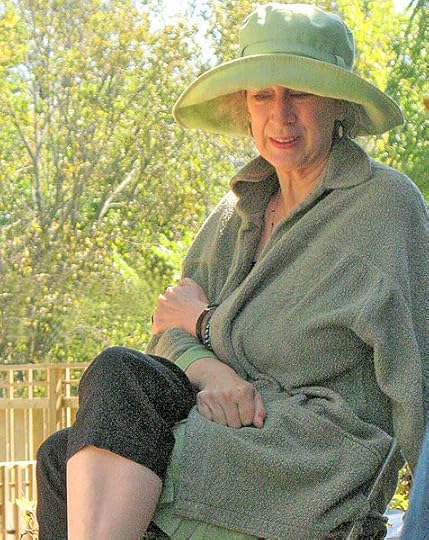 Author Margaret Atwood attends
Author Margaret Atwood attendsa reading at Eden Mills Writers'
Festival, Ontario, Canada in
September 2006.
By Vanwaffle
Source: Wikimedia CommonsMen of Gilead expect their women fill the role of the caretaker (cooking, cleaning, ect). In a way, women are natural caretakers as they give birth and instinctively feel the need to take care of their progeny. Does that mean that women should be responsible for taking care of all household duties, and nothing else? Well, in Gilead, that is exactly what being a woman means. Men of Gilead also expect their women to be natural sluts (but publicly, they denounce wanton sexual behavior). Gilead Commanders maintain a brothel outside of town, named the Jezebel. At Jezebel, women wear ‘retro’ costumes, like lingerie and cheerleading outfits. When Offred asks how a place like Jezebel is allowed, the Commander responds with “Everyone’s human […] you can’t cheat Nature. Nature demands variety, for men. It stands to reason, it’s part of the procreational strategy. It’s Nature’s plan. Women know that instinctively. Why did they buy so many different clothes, in the old days? To trick the men into thinking they were several different women” (p. 308).
Published on August 15, 2012 09:33
August 6, 2012
"Drexel", a science fiction novel by David Curry Holmes and Susan Stastny
Two Atlanta-based authors produced a science fiction novel of epic proportions when they co-wrote "Drexel". Released in March of this year, and already it has garnered positive reviews on Amazon.com and Barnesandnoble.com

5.0 out of 5 stars Great Find April 18, 2012By VtaylorFormat:PaperbackI came across this book on accident and I am so happy I did. I could hardly put this book down it was so good. Its a must read! And I think it would make a good movie too.
5.0 out of 5 stars Page-turning political adventure, April 13, 2012By Sarah - See all my reviewsAmazon Verified Purchase(What's this?)This review is from: Drexel (The Drexel Series) (Kindle Edition)Loved it! Not usually a sci-fi reader, I found Drexel an exciting, intriguing story that kept me captivated throughout. When will the sequel be available?
cellofingersPosted June 21, 2012
This book is a fast ride. I don't need to read a ton of pages to figure out the
characters. They just pop out by themselves. I give it 5 stars!(Summary via Amazon.com):"Let us introduce you to Drexel. A deliciously evil genius who only desires a few simple
things out of life. World domination through his androids, and oh ... total enslavement
of mankind. Can he be stopped? Ask the Queen of England." A senator is shoved out of
an airplane at dawn over the Atlantic Ocean by his android duplicate. Thus begins
Count Drexel's journey of world domination by secretly replacing every nation's political
leaders with identical androids, ranging from senators to heads of state, up to and
including the Queen of England! Drexel's genius and hunger for power knows no bounds,
and his various plots and schemes are as intricate and as scary as is the fast-paced
action of the characters revolving around him. Elliott Greenwood, the Vice-President of
the United States, two Washington Star reporters and their editor, as well as a small
offshoot of MI5 agents, are the only ones between a one-world government run by a
madman and freedom for all its citizens as they try to keep Drexel's evil plans in check
through cunning, courage, and the masterful art of survival.Drexel is available for purchase on Amazon and other literary venues. For more
information, check out the book's press release here:http://www.prnewschannel.com/2012/05/02/new-novel-pits-humans-against-androids-commanded-by-evil-genius/

5.0 out of 5 stars Great Find April 18, 2012By VtaylorFormat:PaperbackI came across this book on accident and I am so happy I did. I could hardly put this book down it was so good. Its a must read! And I think it would make a good movie too.
5.0 out of 5 stars Page-turning political adventure, April 13, 2012By Sarah - See all my reviewsAmazon Verified Purchase(What's this?)This review is from: Drexel (The Drexel Series) (Kindle Edition)Loved it! Not usually a sci-fi reader, I found Drexel an exciting, intriguing story that kept me captivated throughout. When will the sequel be available?
cellofingersPosted June 21, 2012
This book is a fast ride. I don't need to read a ton of pages to figure out the
characters. They just pop out by themselves. I give it 5 stars!(Summary via Amazon.com):"Let us introduce you to Drexel. A deliciously evil genius who only desires a few simple
things out of life. World domination through his androids, and oh ... total enslavement
of mankind. Can he be stopped? Ask the Queen of England." A senator is shoved out of
an airplane at dawn over the Atlantic Ocean by his android duplicate. Thus begins
Count Drexel's journey of world domination by secretly replacing every nation's political
leaders with identical androids, ranging from senators to heads of state, up to and
including the Queen of England! Drexel's genius and hunger for power knows no bounds,
and his various plots and schemes are as intricate and as scary as is the fast-paced
action of the characters revolving around him. Elliott Greenwood, the Vice-President of
the United States, two Washington Star reporters and their editor, as well as a small
offshoot of MI5 agents, are the only ones between a one-world government run by a
madman and freedom for all its citizens as they try to keep Drexel's evil plans in check
through cunning, courage, and the masterful art of survival.Drexel is available for purchase on Amazon and other literary venues. For more
information, check out the book's press release here:http://www.prnewschannel.com/2012/05/02/new-novel-pits-humans-against-androids-commanded-by-evil-genius/
Published on August 06, 2012 11:23
July 28, 2012
"The men are coming! The men are coming!" A summary of "When It Changed" by Joanna Russ
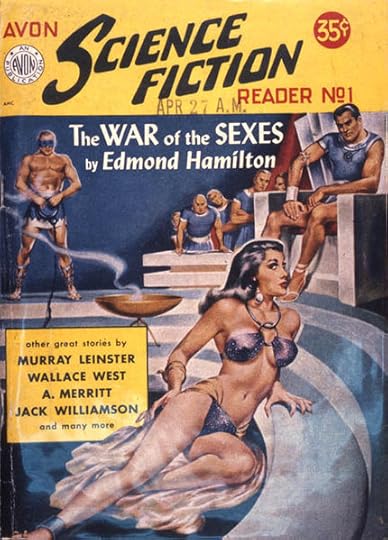 Cover of the fantasy fiction magazine Avon Science
Cover of the fantasy fiction magazine Avon Science Fiction Reader no. 1 (1951)
featuring "The War of the Sexes"
by Edmond Hamilton.
Source: Wikimedia CommonsOn the planet Whileaway, there are no men. The women there hardly notice this because they have learned to survive (and thrive), and also how to reproduce without penetrative intercourse. That is not to say that the women of Whileaway do not enjoy intercourse, but they enjoy it with other women, who they take as wives in a marriage of equality.The narrator, Janet, of Russ's short story appears from the beginning of the story to be a man. It is not until later that the reader understands that the main viewpoint is a woman, a woman speaking of winning duels, wielding guns, and loving her wife, Kate, and their three collective daughters.Four male astronauts land on Whileaway, and interrogate Janet and her family. “Where are all the people?” the men keep asking. Janet does not understand why they keep asking that, but then she sees that when the astronauts say 'people' they really mean 'men'. She tells the astronauts that the men died out six-hundred years ago. At this news, one of the astronauts gives a teary sigh and then says, “We're here now.”Kate believes the men to be dangerous, and even tries to shoot one of them but Janet stops her. Later, Janet wishes she would have followed Kate's instincts and gotten rid of the newcomers. It dawns on her that the men are going to take over the planet of Whileaway, especially after one of them tells her that they need 'the cells of Whileaway'. She tells him that he can have all the cells he needs, but he smiles and tells her they cannot just be given the cells, they must be given through the act of penetrative intercourse (though he doesn't quite say it like that). He tells Janet the Whileaway kind of life is 'unnatural', and to make it natural once again, a dual-natured society must reign again. When Janet tells him that she already has a wife in Kate, the astronaut smiles and assumes that their relationship is based off of a mutually agreed need to survive monetarily. Actual love between two women is beyond the astronaut's understanding.To the Whileaway women, the astronauts seem more like apes than like human men. Janet, Kate, and their daughters do not even find the men attractive. Janet asks her daughter if she would kiss a man, and her daughter scoffs and says she'd sooner kiss a toad.The women of Whileaway are already dual-natured, even if the astronauts cannot see it. Janet thinks wistfully of her daughter going off for the traditional bear-hunt, like a right of passage for a Whileaway woman to become an adult. And Janet shares many traits that would be considered manly as she seems to protect her family, know how to use a gun, and duel to the death with other Whileaway women. At the same time, Janet loves her daughter and loves being a mother. Kate is not a 'weak' woman either, though she seems gentler than Janet. She does not like guns, and so it is a surprise when she grabs Janet's gun with ease and tries to shoot the invaders.Whileaway women defy common stereotypes of women in our culture, and the way they perceive men (though exaggerated) serves as a good example of the exact chasms that separate the two genders.
Russ, Joanna. “When It Changed”. New York: Doubleday, 1972. Print.
Published on July 28, 2012 20:37
June 21, 2012
Analyzing Philip K. Dick's "Do Androids Dream of Electric Sheep?"
 The future of 2020 is a rather bleak one on Earth. World War Terminus has dissolved all living animals and plants, leaving only radioactive dust in its wake. To meet the demand for organic life forms, robotic animals were created, along with human androids. Androids are used in the off-world colonies, but since they are virtually undetectable from humans in most every way, they are banned from Earth. The only thing that sets an android apart from a human is empathy. Androids do not feel empathy for living things, not even other androids. However, is it possible for an unemotional robotic human to evolve into a higher life form? Is it possible that all living things, mechanical or organic, share a similar spark and thus the right to live?
The future of 2020 is a rather bleak one on Earth. World War Terminus has dissolved all living animals and plants, leaving only radioactive dust in its wake. To meet the demand for organic life forms, robotic animals were created, along with human androids. Androids are used in the off-world colonies, but since they are virtually undetectable from humans in most every way, they are banned from Earth. The only thing that sets an android apart from a human is empathy. Androids do not feel empathy for living things, not even other androids. However, is it possible for an unemotional robotic human to evolve into a higher life form? Is it possible that all living things, mechanical or organic, share a similar spark and thus the right to live? These are questions that android-bounty hunter Rick Deckard asks himself while on the quest to ‘retire’ six Nexus-6 androids in a single day. When he meets Rachel Rosen, a Nexus-6 android, her ability to mimic human emotions makes Deckard question his entire profession, and really, his entire outlook on life. Though, in the end, Deckard realizes that the lack of empathy in androids runs too deep. Humans and their ability to empathize with living things are what sets them apart from the mechanical intelligence of androids.
Life on Earth is sacred, mostly because of the after affects of World War Terminus. A new religion has sprung up called Mercerism. Mercerism promotes unity among humans, citing empathy as the greatest link from one human to another. Murders are unheard of (except when androids kill humans in off-world colonies), and the death of an animal is cause for a serious depression. Even the idea of killing an insect like a spider would be abhorrent to the future citizens described by Dick.
In Phillip K. Dick’s novel, there are parallels with other SF futuristic novels, like Ray Bradbury’s Fahrenheit 451. Both men have wives that are unsatisfied with their lives. In fact, in both novels, the wives and their displeasure serve as an extension of the main male character’s own dissatisfaction, almost like a foreshadowing of the unpleasantness to come. In the beginning of Dick’s novel, Deckard is happier (well, happier than his wife) and trying his best to help his wife out of her depression, but by the end, she is the one taking care of her husband as he is a broken man after retiring six andys.
As for the theme of communal human emotions in the novel, it ran in the same strain of the communal telepathic climate found in Olaf Stapledon’s Star Maker. The Earth setting described in Dick’s novel is a mirror comparison of the Utopian worlds found by the protagonist in Star Maker; citizens of Deckard’s Earth share their emotions through an empathy box, fusing their minds and emotions together. When Deckard comes home in a good mood, his wife implores him to share his mood with the world, telling him that it would be immoral not to.
As a reader, I kept expecting the world described by Dick to be a dystopian one, and in a way it is. People are given health and IQ tests, and if they do not pass, they are labeled as ‘special’, a term that prohibits them from mating or immigrating to off-world colonies. Another flaw of the world is the eventual ruin of Earth, as the radioactive ash is slowly covering (and devouring) everything. Through all of the prejudice and physical ruin of the Earth, the people of this futuristic setting manage to leave peacefully with one another. It is sad to think that it took a nuclear war to make them understand the true value of life, and of each other.
Dick, K., Philip. Do Androids Dream of Electric Sheep? New York: Doubleday, 1968. Print.
Published on June 21, 2012 19:54
June 9, 2012
Preview of untitled Red Harvey project, coming soon
The glass hospital doors dissipated to allow the paramedics to enter the hospital. Once they had crossed over the threshold with their burden, red lasers brought the faux glass back into place.A young doctor on call approached the team of paramedics, gesturing to the man they had wheeled inside. “What’s his story?”One of the paramedics answered. “He suffered cardiac arrest, and I defibrillated him on the way over. Got a heartbeat on him, but he’s still out.”From her front pocket, the doctor removed a long white object about the size of a pen. She bent over the unconscious form of her new patient to peer into his face. With one hand, the doctor opened the man’s eyelid, and with the other hand, she waved the pen across his unseeing eye. A green laser scanned his exposed pupil. The doctor stepped back, holding up the pen. Along the side of it, a red holographic panel appeared. On the panel was John Doe’s photo and background information (his religious affiliations, occupation, address, credit report, and net worth, in that order).Both his credit and net worth were below average, which would have been fine, but not in combination with an “N/A” under religious affiliation. The doctor weighed all of the factors in combination, and sighed.“Sir, by law, I am required to offer you the option of Amnesty in lieu of payment. Should you wish to decline this offer, then you will be taken to an alternative hospital.”Amazingly, the offer did little to rouse the unconscious man. The doctor sighed again.“Alright. Take him to Tranquility Hospital.”This time, the second paramedic spoke. “Ah, c’mon ma’am. That’s over twenty minutes away, and we’ve got more people to pick up. This guy isn’t even awake, just take him.”“Sorry, I can’t do that. You saw his report.”“Yeah, I’m sure you’re real sorry.” The first paramedic replied under his breath.“What was that?” The doctor asked with narrowed eyes.“Nothin’. We’re goin’.”Both men wheeled the gurney towards the dissipating glass doors; now ya see ‘em, now ya don’t.“Wouldn’t wanna report you boys for Un-Christian-like conduct.” The doctor called after them.In response, the paramedics rolled their eyes. They were suddenly glad to drive away from the State hospital.Inside, the doctor nudged the attendant nearest her. “You hear all that noise?”The nurse nodded. “Everyone expects a free ride these days.”****
Tranquility Hospital did not live up to its name. Unlike the waiting room at the State hospital, it was filled with patients in dire need. Another difference between the two hospitals was the decorum.Staff at Tranquility mirrored the dismal surroundings: peeling paint, dingy floors, and entry doors to the e.r. that slid open on a mechanical belt instead of the standard dissipating doors. There were no pristine counters or smiling nurses. What Tranquility did have was a steady influx of sick people.When paramedics wheeled in the man the State hospital had refused, they were not received with prompt service. They were used to as much at Tranquility, and so, they felt little shame in parking their burden by the nearest dirty wall. After that, they left the way they’d come in without saying a word to anyone about their arrival, subsequent departure, or their patient’s condition.Seemingly stabilized, John Doe was not a primary concern at Tranquility. Cutbacks in trained staff had forced Tranquility to reassess its definition of ‘patients in need upon arrival’. From a Tranquility point of view, John was not currently in need.He lay by the wall, unattended for ten minutes, twenty minutes, thirty minutes. Finally, a woman came over and wheeled him away. No one had paid attention to John’s presence thus far, and his departure went unnoticed as well.The woman took him down an empty hallway that was not meant for patients. She stopped at a door marked ‘Staff Only’. Where a doorknob should have been, there was an acrylic keypad. The woman touched her finger to the pad, but not to enter in a combination. It was obvious from her jeans and hooded sweatshirt that she was not a member of the Tranquility Hospital staff. Jeans or no, the door opened at her touch and she wheeled the man in.Inside the room, there were storage boxes, utility supplies, and space to spare for a private conversation. After closing the door behind her, the woman perched on a stack of boxes. She assessed the sleeping man in front of her. She appeared to be making a decision. The room was silent until John Doe’s unconscious fart escaped his ass. A smell not unlike raw sewage filled the small room and the woman coughed. When her lungs cleared, she touched a finger to the man’s chest, her fingers emitting a blue spark.John Doe was suddenly awake as he’d never been before in his entire life.He looked around the room, and then at the woman. He didn’t ask “Where am I?” He didn’t ask “Who are you?” What he asked was:“What’d you do to me?”“What I promised. Now that you know I’m serious, I hope you’ll tell me what I want to know.”“I don’t remember, Cleary.”From the look of the man, remembering was the last thing on his mind. He was clutching his chest and breathing shallowly. Every few seconds, his eyes kept scanning the room, looking for a way to escape. The man’s well-being could mean less to Cleary. These days, she was as narrow-minded in her pursuit of information as a Prominent.“You remember.” Cleary said.The man lay back on his cot. He seemed defeated. “Well, I know he moved, but that’s it.”“Where?”“I don’t know.”“Where?” Cleary repeated.A blue spark fired from her fingertips and she held it above John Doe’s heart. Small whimpers issued from his slack mouth. With the little bit of strength that remained within him, John crawled backwards, away from the menacing heat of Cleary’s hand.“Okay! He moved to Atlanta. That’s all I know!”Cleary withdrew her hand. “Why was it so hard to tell me that the first time?”“You’ll know when you meet the bastard.” John panted.Cleary laughed. Everyone she had questioned had referred to her father by that name at some point in the conversation. When she finally met Matheson, Cleary thought she might just refer to him as ‘bastard’ indefinitely. Calling him ‘papa’ was certainly out of the question.Bitch, John thought as Cleary left the storage room. The hospital bill he would incur was bound to cost him at least a year’s pay.****
Published on June 09, 2012 12:14
June 2, 2012
"A Princess of Mars"- A novel where being a princess means being helpless
 is a former Virginian confederate officer. Penniless after the end of the Civil War, Carter is not without courage, honor, and a friend: James Powell. When Powell is taken by a band of Native Americans, Carter follows and finds his friend dead. He later takes refuge in a cave and is almost overtaken by the same band of Native Americans. Though, some noise or presence scares them off (maybe a foreign spacecraft; Burroughs never says) and when Carter next awakes, he is on the planet Mars. The first sign of life Carter is exposed to are green men called the Tharks. They are a harsh sort of civilization, comparable to the culture of Spartans. They relish brutality, respect violence, and laugh only when these two things occur. Carter is lucky because he kills two of their chieftains, and gains the Tharks esteem, becoming a chieftain himself. His female mentor (all Tharks are raised by female mentors, not mothers or fathers) is Sola, and she shows him compassion and kindness. Carter’s other companion on Barsoom (the Thark word for Mars) is his dog-like companion, Woola.
is a former Virginian confederate officer. Penniless after the end of the Civil War, Carter is not without courage, honor, and a friend: James Powell. When Powell is taken by a band of Native Americans, Carter follows and finds his friend dead. He later takes refuge in a cave and is almost overtaken by the same band of Native Americans. Though, some noise or presence scares them off (maybe a foreign spacecraft; Burroughs never says) and when Carter next awakes, he is on the planet Mars. The first sign of life Carter is exposed to are green men called the Tharks. They are a harsh sort of civilization, comparable to the culture of Spartans. They relish brutality, respect violence, and laugh only when these two things occur. Carter is lucky because he kills two of their chieftains, and gains the Tharks esteem, becoming a chieftain himself. His female mentor (all Tharks are raised by female mentors, not mothers or fathers) is Sola, and she shows him compassion and kindness. Carter’s other companion on Barsoom (the Thark word for Mars) is his dog-like companion, Woola.
 Cover art by Frank Earle Schoonover
Cover art by Frank Earle SchoonoverAC McClurg Publishing, 1917
Source: Wikimedia CommonsCarter finds out that there are other humanoids on Barsoom when he meets Dejah, a captive of the Tharks. She looks like an Earthling, but for her copper skin. Through her, he learns that Barsoom thrived over a thousand years ago, but due to failing resources, it fell into a state of disrepair ruled by the warring Tharks and other creatures. A constant theme (and perhaps even a fear held by Burroughs) is the unjust nature of a communal civilization, as displayed by the Tharks. Personal possession is unheard of, unless it is something consequential like a blanket. Children do not learn love or even who their parents are. From the first year, they are taught warrior codes, and always to fight for what they want. Tharks do not even recognize love or friendship when the concepts are presented to them by John Carter. “Friendship?” asked Tars Tarkas. “There is no such thing.” (p. 62). Dejah laments the loss of love from the Tharks, a race that once mixed with her own to create hybrid Barsoomians.Burroughs chooses to make the female character of Sola independent, brave and strong (as she is a Thark). Yet, the more ‘civilized’ female character, Dejah (the Barsoomian Princess of Helium), is not either of those things. Carter thinks of her as ‘earthly womanly’, giving that comparison whenever Dejah displays affection, weakness, or abject stupidity (at least, she does not seem that bright to me, the reader). For example, when Dejah convinces herself that Carter is an alien, she does not do so from any deductive reasoning, but rather she says her conviction comes from “her heart telling her to believe because she wishes to believe it”, a logic that Carter deduces is a “good logic, good, earthly, feminine logic.” (p. 48-49). It seems that Burroughs idea of a Communist society was one in which barbaric pleasures reigned, as the Tharks did nothing but create a menacing picture of a communal faction, unlike the Utopian commune depicted in Gilman’s Herland. Carter’s ideas on ‘real’ women are borderline offensive at times, but probably reflective of the decade in which the novel was written.
Burroughs, Rice, Edgar. A Princess of Mars. Chicago: AC McClurg Publishing. 1917. Print.
Published on June 02, 2012 07:47

